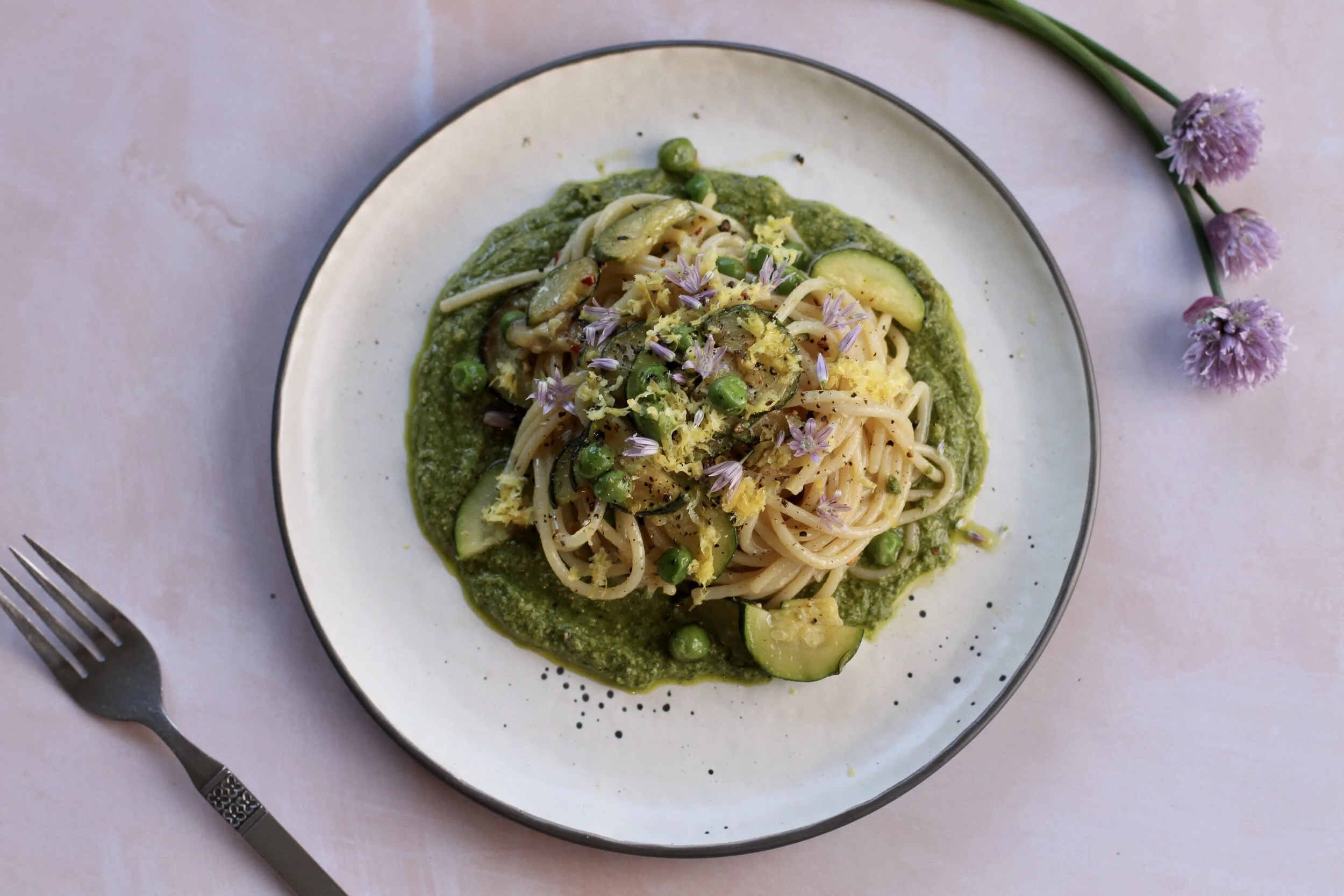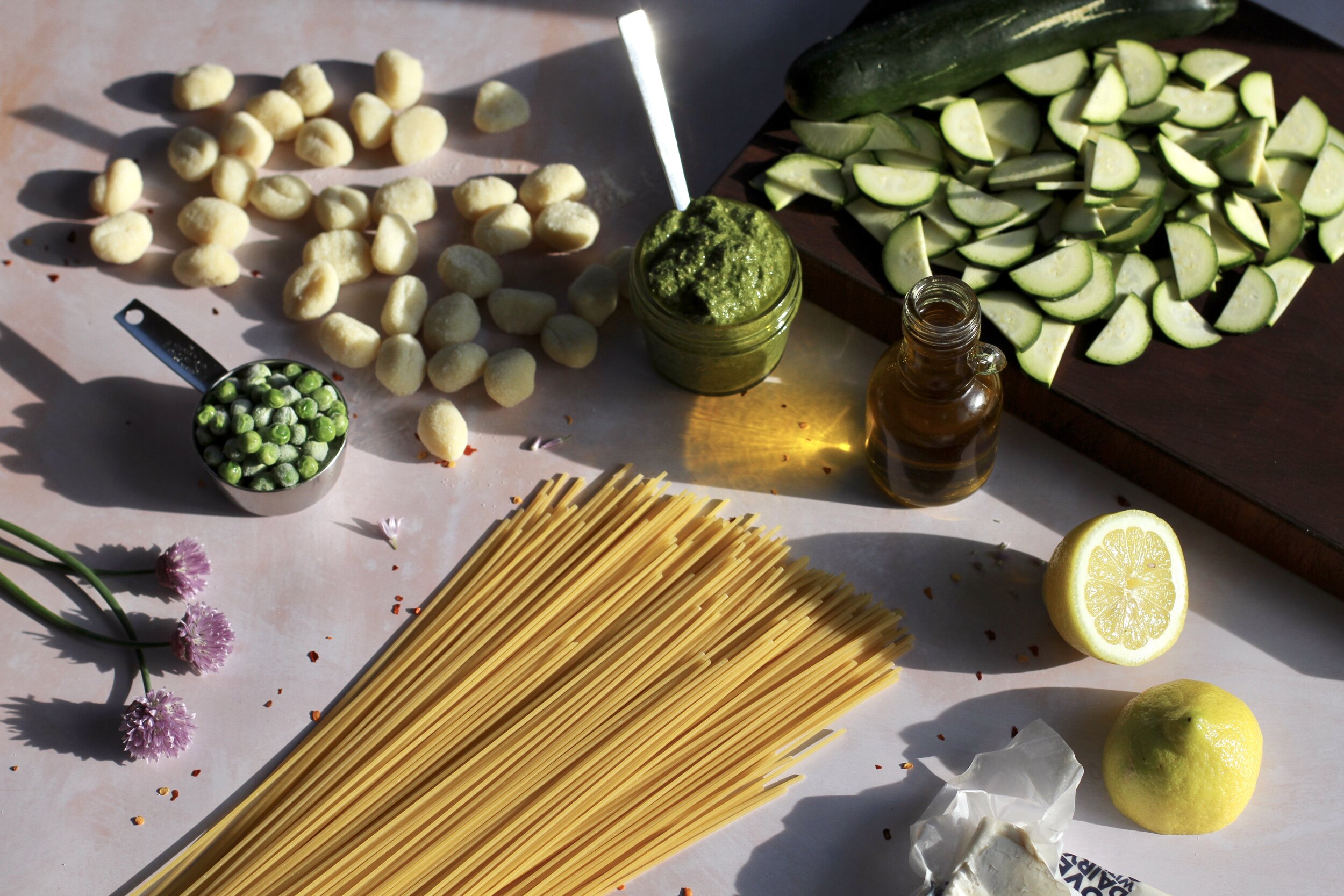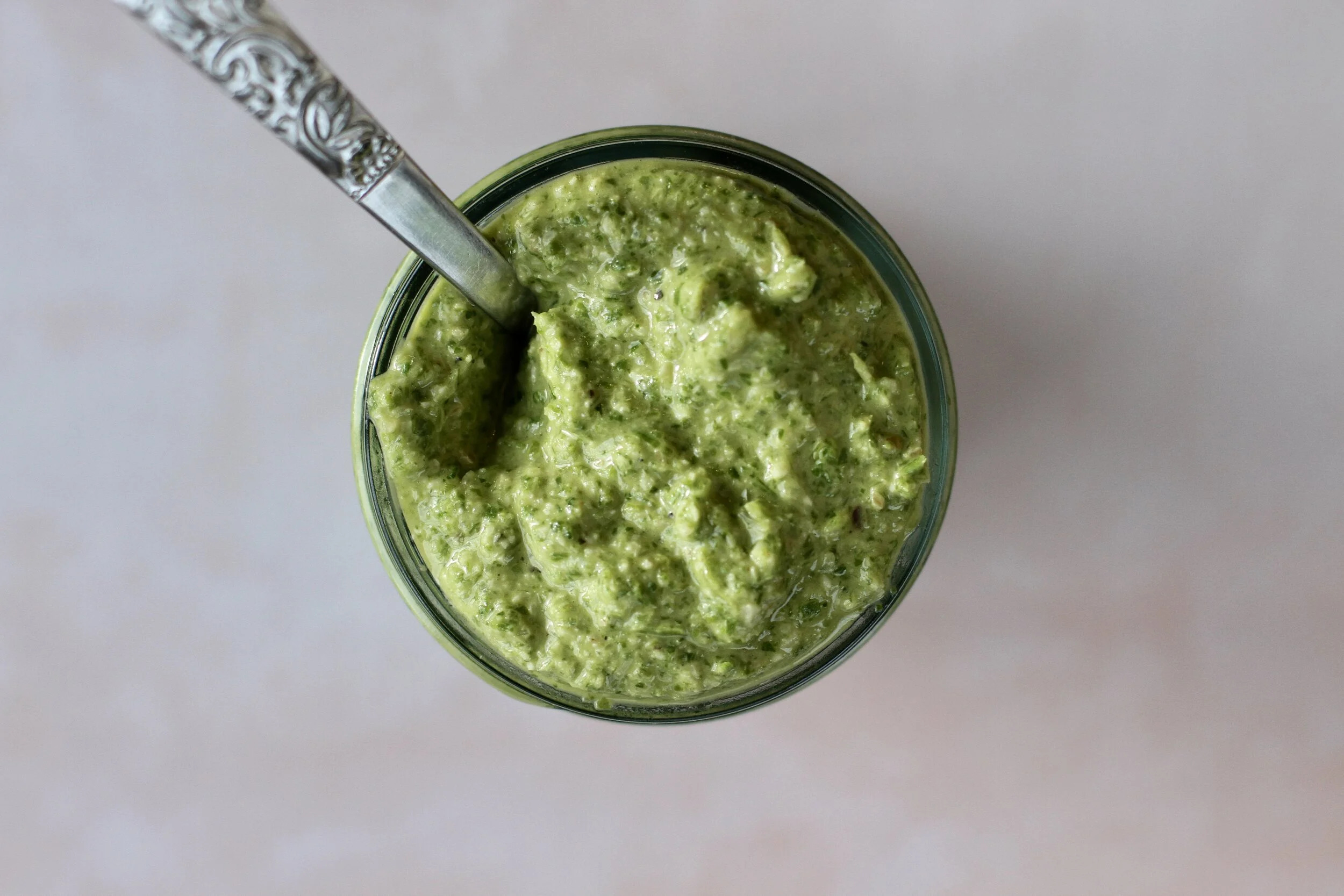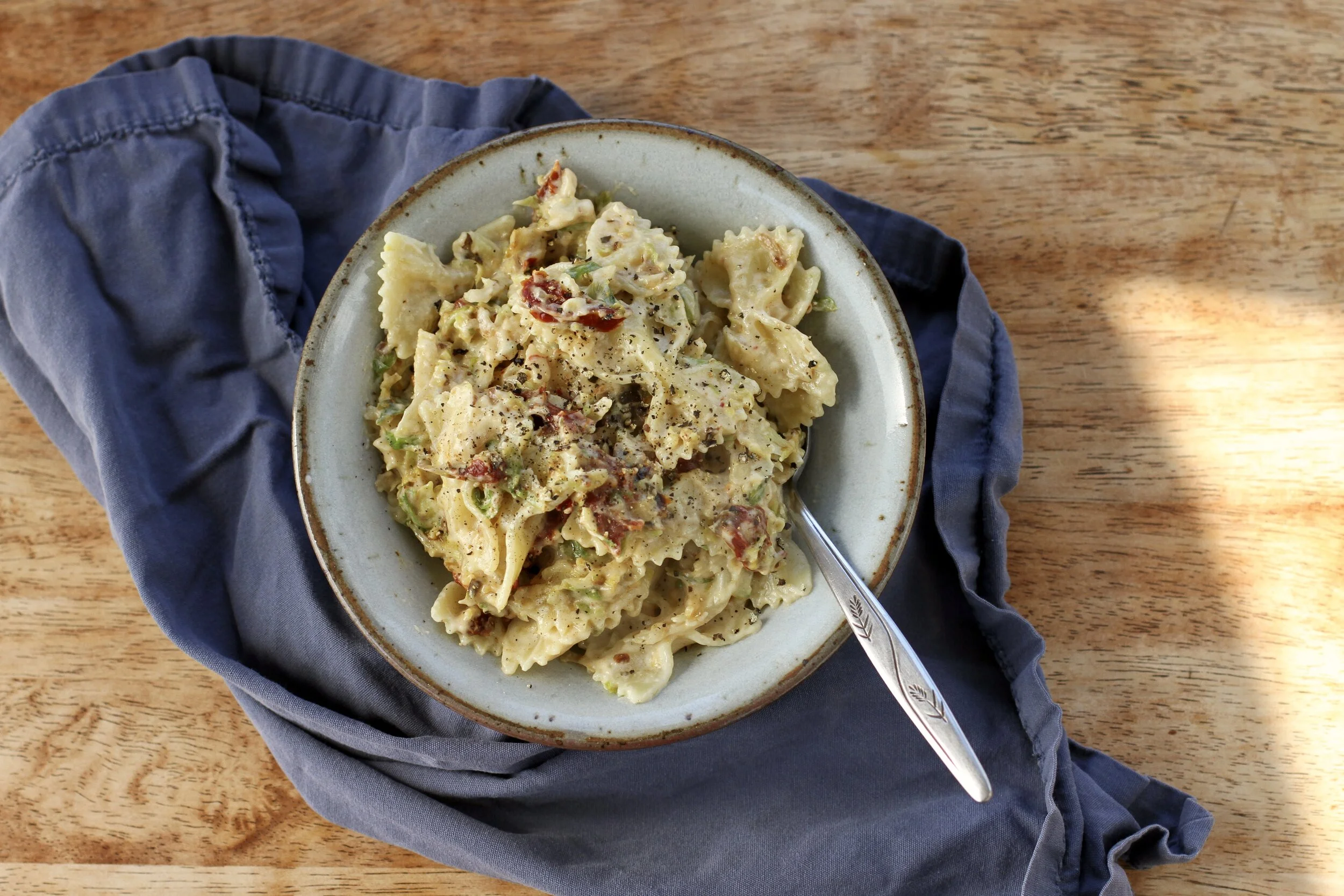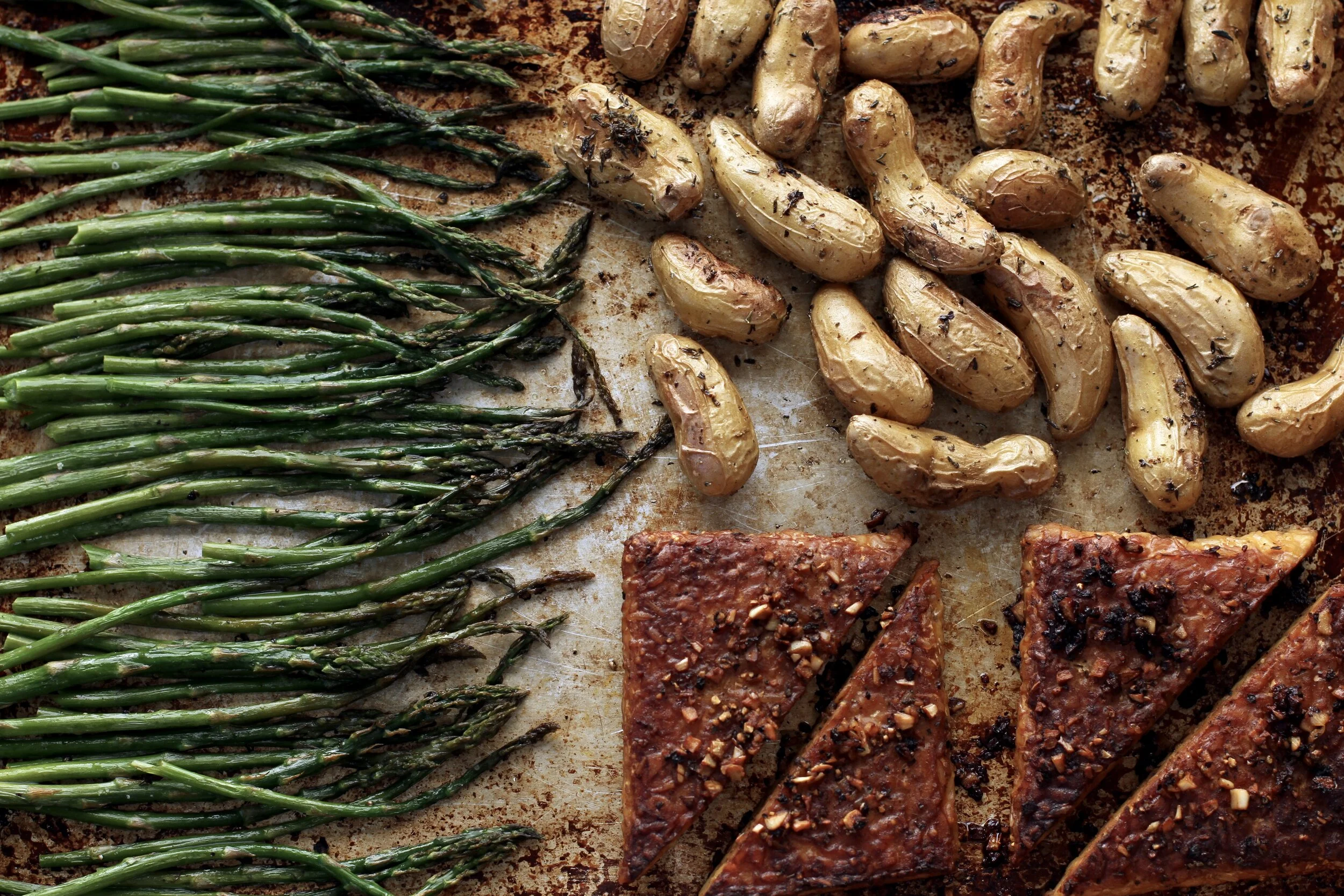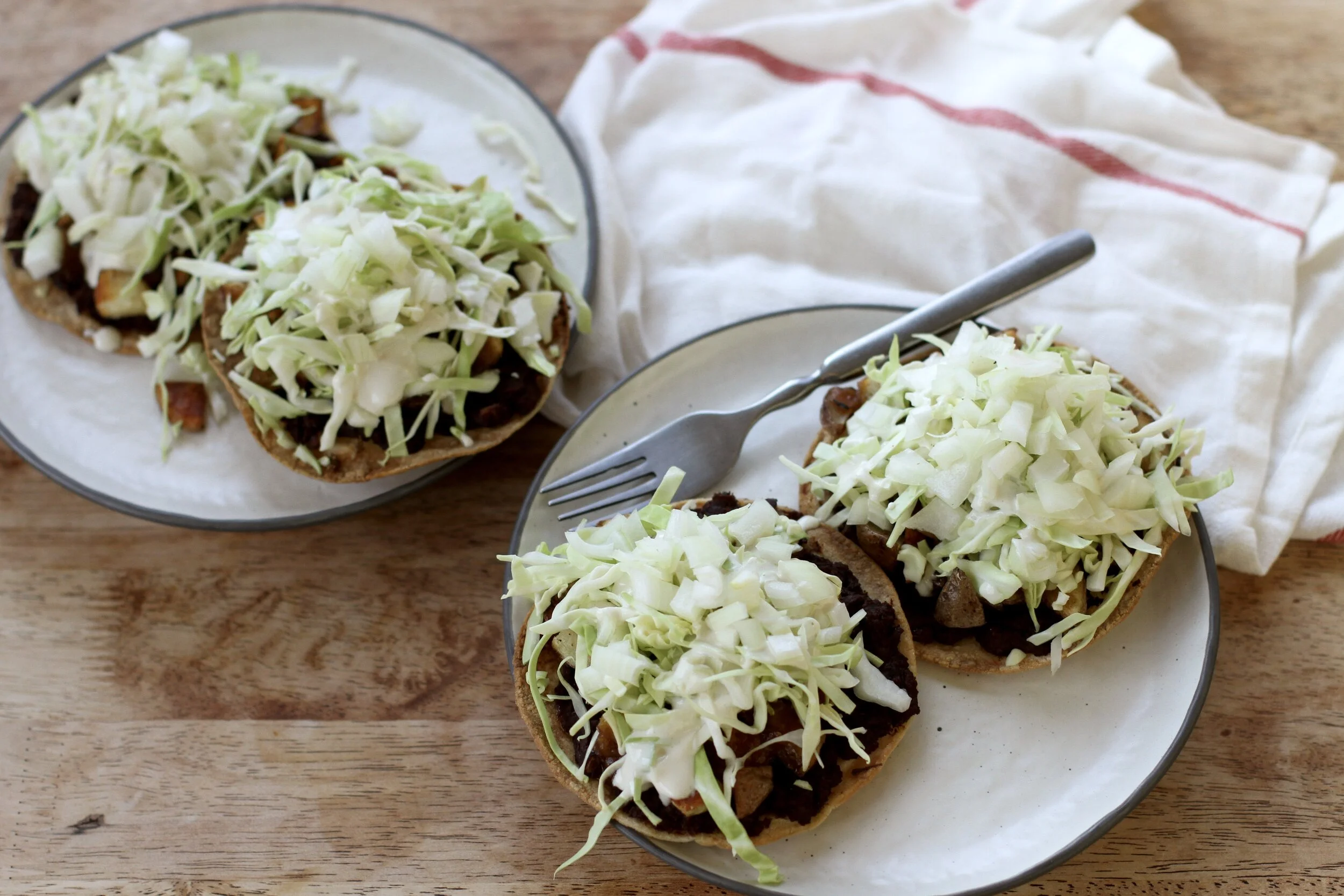Late Spring on a Plate — Vibrant Pasta Primavera with Zucchini, Peas, and Pesto
Late Spring by Mary Oliver (from Felicity part II)
Finally the world is beginning
to change, its fevers mounting,
its leaves unfolding.
And the mockingbirds find
ample reason and breath to fashion
new songs. They do. You can
count on it.
As for lovers, they are discovering
new ways to love. Listen, their windows are open.
You can hear them laughing.
Without spring who knows what would happen.
A lot of nothing, I suppose.
The leaves are all in motion now
the way a young boy rows and rows
in his wooden boat, just to get anywhere.
Late, late, but now lovely and lovelier.
And the two of us, together – a part of it.
Mary Oliver’s poetry is remarkable in its ability to describe the way that our inner rhythms reflect the outer rhythms of the natural world we reside in — every word finding resonance in the space between the uniquely human and universally animal parts of ourselves. This poem, in particular, feels almost too on-the-nose for these times we’re living in. Late spring in 2020 sees us all in uncharted waters.
Finally the world is beginning
to change, its fevers mounting,
its leaves unfolding.
It is true that without the spring, a lot of nothing would happen. No flowers, no fruits, no harvest, no babies. No mama bears or tulip bulbs awakening from their winter slumber. While the human world has held its collective breath, hidden in homes and staying apart… The spring still awakens these wild forces within and around us. We can feel these rhythms rise and fall like so much ample breath. We can sense them as we rearrange our closets and notice them as sunlight lingers, even after dinner dishes are done. We can, hopefully, see it on our plates as well — Spring is, after all, a highly edible season.
Late spring is especially magical. The intersection of spring’s renewal and summer’s effervescence brews up a special sort of aspirational, hopeful joy… It seeps in through open windows and fresh berries and evening drinks on the balcony. May and June bring us produce that epitomizes the vibrance of the two seasons as they shake hands.
This pasta, on the surface, does not feel very fancy or involved to make — in fact, it only takes about as long as bringing water to a boil and cooking pasta once you get the hang of it. But by highlighting vibrant veggies and layered sauces, it punches way above its culinary weight. It’s a bridge between pantry-friendly and produce-forward, using fresh and frozen produce along with our pesto recipe aimed at reducing personal food waste. It might even impress a sweetie for an at-home date night.
As for lovers, they are discovering
new ways to love. Listen, their windows are open.
You can hear them laughing.
Pasta Primavera — literally “Spring Pasta” in Italian — Is an American invention of the 1970s that usually consists of long noodles, seasonal vegetables, and a buttery sauce… We didn’t mean to walk right down that avenue when developing this recipe, but it seems the concept of multiple independent discoveries even applies to seasonal pasta. The pasta is even good on its own, without the pesto. By emulsifying two different fats (olive oil and butter) with salty pasta water, you create a simple glossy sauce that lets the creamy-sweet peas and zucchini shine in the mix. Black pepper, red pepper flakes, and lemon zest cut through the richness to prevent it from becoming cloying and provide bright focal points on the plate. Serving the pasta atop cool pesto rather than mixing it in not only looks nice but also provides a more interactive dining experience with a juxtaposition of hot and cold — a sensation that is decidedly late spring. Flowers from an herb like chives or rosemary are a lovely garnish if you have some.
There are some tips below to help you live your vibrant pasta dreams. Write us if you want any help adapting this or any other recipe to suit your needs, or if you just want to say hello. Pay attention to the rhythms outside and in.
Late, late, but now lovely and lovelier.
And the two of us, together – a part of it.
Tips & Info
We love frozen peas. We almost always have a two-pound bag in the freezer — since peas have such a short season, it’s quite a privilege to be able to have them around often. If you are lucky enough to have fresh peas in your house, it’s probably the middle two weeks of June! You can use them instead of frozen ones, just boil them for about 3 minutes in your pasta pot before you add salt and pasta — salted water can turn them tough. Skim them out and set them aside to be added back later, then add salt and cook your pasta like normal.
The pasta type is a choose-your-own-adventure. With limited imports and reduced grocery trips, our advice is to use what you have! That said, as you can tell from the photos, our favorites were gnocchi and spaghetti for this dish. Wanna use rigatoni? Make homemade gnocchi? Use some fresh linguine you got at the farmers market? More power to you — go wild. Our only advice is to do the math on cook times before you’re elbow-deep in cooking. The zucchini takes an average of 6 minutes to cook — Gnocchi takes 3 mins to boil? Then cook the zucchini for about 3 minutes before you boil the gnocchi. Spaghetti takes 11 minutes? Drop the zucchini in the pan 5 minutes after the noodles hit the water. Capeesh?
No radish tops? Just like the pesto recipe says, you can make pesto from whatever greens you’ve got around! Chard? Arugula? Turnip tops? Kale? Go for it. Heck, we’ve even heard that basil leaves make a good pesto. Wild, I know. (Store-bought pesto is acceptable here, too, if that’s better for ya.)
Speaking of pesto… If your pesto is refrigerated, set it out when you are gathering your other ingredients before cooking so it has time to come closer to room temp. Olive oil coagulates at fridge temperature and you want to give it some time to relax back to a nice serving texture.
No vegan butter? Just use a little more olive oil. Sure, it won’t be quite as creamy and layered without the butter, but you’ll still love it.
Serving-wise, this pasta was originally designed to use a whole package of dried gnocchi, making it 4 servings. Cut it in half, double it, or leave it as is. Whatever you see fit to feed you and yours well.
Make a meal out of this dish — Literally and figuratively. Light a candle. Pour some dry white wine. Drop the needle on your favorite record. Put some cushions on the stoop. Whether you’re dining in with a sweetie, al fresco with family, with friends over a webcam, or by yourself — this vibrant, rich, fresh, luxurious pasta is an excuse to slow down and savor a fleeting spring evening.
Power Plant Pasta Primavera with Pesto

Power Plant | David Griffin-Luna | May 22, 2020
Time: ~30 minutes | Makes: ~4 servings
Equipment:
Ingredients:
Preparation:
1) Bring 3-4 quarts of water to a boil. Meanwhile, heat a skillet or sauté pan over medium-low heat. Refer to the tips in the blog post for this recipe and make a plan for your cooking times depending on ingredient factors.2) Either before or during the zucchini’s cook time, depending on the pasta — Add pasta to the pot of boiling water and cook al dente according to package directions.
3) Raise sauté pan heat to medium. Add 2 tbsp olive oil to pan along with the zucchini, a pinch of salt, and pepper flakes. Cook, stirring infrequently, until creamy-tender and lightly caramelized (4-6 mins).
4) Reserve 1 cup of starchy pasta water. Add peas to the pasta water right before draining (cooking frozen peas in hot water rather than the sauté pan keeps them from shriveling). Drain pasta and peas and set aside in preparation of final sauté stage.
5) Once the zucchini is done cooking add butter, a small splash more olive oil, and 5 or so grinds black pepper to the pan. Add in pasta and begin tossing to coat (careful not to let it sit on the bottom and stick). Stream in ¼-½ cup pasta water, sautéing until a glossy sauce that sticks to the noodles forms.
6) To serve: Spoon ¼ cup pesto onto the center of each plate. With the back of a spoon, smear the pesto into a “donut” shape. Coil/spoon pasta over top, covering the “donut hole.” Top with a couple more grinds of black pepper, lemon zest, and some herb flowers if you’ve got ‘em. Enjoy!
